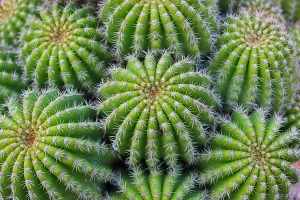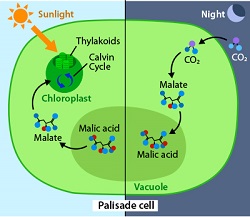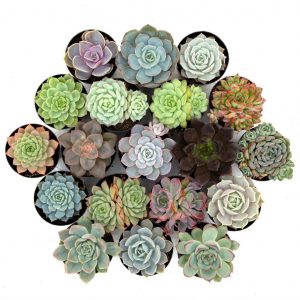BY MADISON RAE | SQ ONLINE WRITER | SQ ONLINE (2017-18)
Between UC San Diego’s student organizations’ sales pitches and sponsored craft events, succulents are nearly always available on campus. Off campus, one only needs to go as far as a local hardware or grocery store to find these plants for less than $10. In sunny California, they make many appearances over the holiday season. Some are spiky and thin, while others look like they might pop from all the liquid they store. What are these cute little plants, and how did they get so popular?

Succulents have thick fleshy leaves – or stems, in the case of cacti – for maximum water storage. The leaves often have a rubbery, waxy surface to prevent water loss in dry, hot weather. Many succulents, most notably cacti, also perform photosynthesis differently from most other plants; they use a process called Crassulacean Acid Metabolism (CAM). Most plants take in carbon dioxide throughout the day through the pores in their leaves, losing water in the process. Cacti and other succulents collect carbon dioxide at night, to minimize water loss in the cooler temperatures. Carbon dioxide is stored as malic acid overnight, and returned to its normal state during the day to complete photosynthesis. Cacti are in a bit of a grey area in the horticultural world: they fit all of the characteristics of succulents, but have noticeable differences in leaf structure and other needs. They store water in their large stems, and their spines take the place of leaves.

Since succulents store so much water in their leaves and stems, it’s easy to think that watering them frequently is best. However, over-watering can actually kill them. Because they are mainly desert plants, succulents are not used to sitting in water. Their watering needs are similar to desert floods and rainstorms: totally dry soil, with full soaking and fast drainage when rain does fall. So, the best soil for succulents does not hold much water. Garden centers often sell “cactus soil” for this purpose, and many people add small pumice or perlite stones into their soil mixes to help the soil drain. A pot with one or more drainage holes is a must so excess water can flow out. Adding stones to the bottom of a pot is a common solution to drainage issues, but for succulents, adding stones actually decreases their “breathing room” and increases space for water to sit in the soil. If they do sit in damp soil for too long, their roots can begin to rot, which will eventually kill them.
While many are desert plants, some succulents are not aren’t able to withstand direct sunlight for many hours a day. Those plants are usually more suited to indirect sunlight, similar to growing in the shade from a taller plant. Plants that need more light will etiolate, stretching at strange angles to reach toward the nearest light source. Plants that need less light will wilt and look almost sunburned. “Stressed” succulents may begin to blush, or show colors besides green; this could be from underwatering or from an amount of light that is more than they need but will not burn them. As long as a succulent is receiving enough water, blushing is normal and gives them beautiful color variety. Getting the right amounts of water and light is key to keeping your succulents healthy, so learning about the type of succulent you have can make caring for them much easier.

How did these strange plants become so popular? Social media sites like Pinterest are certainly helpful, with thousands of photographs and do-it-yourself suggestions. Succulents are currently popular choices for terrariums – often small glass containers filled with soil and different plant varieties – and other plant arrangements, and even special occasion items like bouquets, corsages, and boutonnieres. They look noticeably different from most other plants; some have endearing puffy leaves and sweet color schemes, while others look spiky and extraterrestrial. Succulents are also famously low -maintenance plants, often described as unkillable. Some of these preconceptions are true, but some can be potentially harmful to your plants: terrariums hold too much moisture and can cause rot, and some of the less hardy succulent species can be killed from lack of attention. They require some maintenance, like any other houseplant. The most enticing part of collecting succulents? They’re often quite cheap, and small plants are sold for very low prices nearly everywhere nowadays. Many UCSD students and organizations sell small plants for less than $10, and some crafting events give away a limited supply to attendants. Any garden store or even stores with gardening sections carry them, and some grocery stores have started selling them as well. Because they’re cute and low priced, they might even have made an appearance this holiday season.
However, buying succulents is not the only option; it is possible to grow new plants from existing plants through the process of propagation. For hardy succulents with many individual leaves like Echeverias, twist a leaf and pull it off at the very base. For plants that require cuttings like Aeoniums, use sharp scissors to make a clean cut along the bottom of a large leaf or a stem. In both cases, let the cutting callous, or heal over, before placing it in soil and watering it – this prevents the cutting from taking in too much water and dying before it can take root. Propagating from a small leaf should result in a very small version of the adult plant growing from the callous, while a larger cutting should result in a larger plant. Some plants, like Aloes, may even grow pups – smaller versions of themselves – that can be removed and planted elsewhere. All in all, succulents are quite hardy, and make great houseplants and garden plants.
Take a look around San Diego, and see all of the strange and wonderful succulents growing alongside us. Because the climate is sunny and dry, they flourish year round. Consider adding them to your home alongside other native California plants for a drought resistant garden.
To see what succulent species are native to San Diego, check out this guide.
This article’s featured image can be found here.
[hr gap=”0″]
Sources:
https://www.succulentsandsunshine.com/how-to-propagate-succulents-from-leaves-and-cuttings/
https://www.installitdirect.com/blog/succulents-that-are-native-to-san-diego-ca/
https://www.ambius.com/blog/the-ultimate-guide-to-succulents/
https://askabiologist.asu.edu/cam-plants
https://www.succulentsandsunshine.com/why-did-my-succulent-change-colors/
https://leafandclay.co/collections/succulents
https://www.lovethegarden.com/plant-finder/indoor-plants/desert-cactus